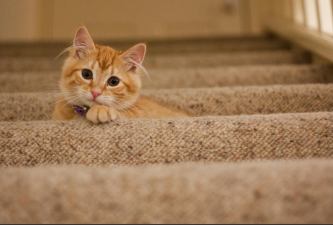
1. Climbing Counters: Why They Do It and How to Redirect
Cats love heights—it gives them a sense of security and a bird’s-eye view of their territory. But when they scale your kitchen counters, it’s often for food, water, or shiny objects that catch their eye.
Solutions:
· Remove temptations: Clear counters of food, water bowls, and small trinkets.
· Offer vertical alternatives: Place cat trees or wall-mounted shelves near windows or high-traffic areas.
· Use deterrents: Sticky tape, aluminum foil, or motion-activated noise devices can discourage climbing.
· Reward ground behavior: Praise or treat your cat when they stay off counters.
Pro Tip: Don’t ban climbing entirely—cats need this activity! Provide better options to satisfy their instincts.
2. Meowing at Night: Restoring Peaceful Sleep
Nighttime meowing can stem from health issues (especially in senior cats), pent-up energy, hunger, or loneliness.
Solutions:
· Rule out health problems: Visit the vet to check for pain, dementia, or other conditions.
· Tire them out before bed: Engage in active play (e.g., feather wands) 30 minutes before bedtime.
· Fill their belly: A small meal before bed can curb hunger-induced meowing.
· Ignore the meow: Responding reinforces the behavior; instead, wait for quiet to reward.
Pro Tip: Meowing is communication. If the behavior persists, observe patterns—are they asking for something specific?
3. Eating Plants: Safety and Redirection
Cats chew plants for fiber, curiosity, or even boredom. But many common houseplants (lilies, ivy, pothos) are toxic.
Solutions:
· Remove toxic plants: Replace them with cat-safe options like spider plants or parlor palms.
· Offer cat grass: Grow organic cat grass to satisfy their need to chew.
· Enrich their environment: Add puzzle toys, climbing towers, or window perches to reduce boredom.
· Use bitter sprays: Apply pet-safe bitter deterrents to plants you want to protect.
Pro Tip: Punishing chewing worsens stress. Redirect their urge to safer outlets.
4. Knocking Things Over: Curiosity or Attention?
That vase on the shelf? Your cat might knock it over out of curiosity, boredom, or a bid for attention.
Solutions:
· Minimize temptations: Move small, valuable items to closed cabinets or higher shelves.
· Offer puzzle toys: Treat-dispensing balls or interactive feeders keep them occupied.
· Ignore attention-seeking: If they knock things for a reaction, stay calm and avoid eye contact.
· Reward good play: Praise and treat when they interact with toys instead of your belongings.
Pro Tip: This behavior is rooted in natural curiosity—channel it into positive activities!
5. Biting Hands: From Play to Pain
Hand-biting can start as playful roughhousing but may signal overstimulation, fear, or pain.
Solutions:
· Identify triggers: Notice when bites happen—during play, petting, or when startled.
· Redirect with toys: Offer a chew toy or wand when they get nippy.
· Respect boundaries: Stop petting if they twitch their tail or flatten their ears (signs of overstimulation).
· Reward gentleness: Praise and treat when they nuzzle or paw gently instead of biting.
Pro Tip: Never punish biting—it erodes trust. Instead, teach alternative behaviors.
6. Litter Box Issues: Beyond “Bad Behavior”
Avoiding the litter box often signals discomfort (dirty box, wrong type) or medical issues (UTIs, arthritis).
Solutions:
· Optimize the setup: Use a large, low-sided box (senior-friendly), place it in a quiet area, and scoop daily.
· Check for health problems: A vet visit rules out UTIs, kidney disease, or pain.
· Avoid punishment: Yelling or moving the box increases stress—worsening the problem.
· Create a calm space: Add a second litter box in a private spot for multi-cat households.
Pro Tip: Consistency is key—stick to the same litter type and cleaning routine.
7. Fear of Guests: Helping Shy Cats Feel Safe
Strangers can terrify cats, especially if they’re sensitive or unsocialized.
Solutions:
· Create safe zones: Set up a quiet room with food, water, and a hiding spot (e.g., a covered bed) for guests.
· Let them take the lead: Never force interaction—allow your cat to approach guests at their own pace.
· Use familiar scents: Place a blanket with your scent near their hiding spot to comfort them.
· Reward calm behavior: Offer treats when they peek out or stay relaxed around guests.
Pro Tip: Not all cats want to be social! Respect their boundaries—they’ll trust you more for it.
8. Hiding Constantly: When Safety Comes First
Cats hide to feel secure, but excessive hiding may signal stress, illness, or a noisy environment.

Solutions:
· Respect their space: Never drag them out—they’ll emerge when ready.
· Provide cozy hideouts: Cardboard boxes, cat tents, or covered beds give them control.
· Reduce stressors: Keep loud noises (vacuums, parties) to a minimum; use calming pheromone diffusers.
· Use scent familiarity: Leave a worn shirt in their hiding area to reassure them.
Pro Tip: Hiding is a survival instinct. Build trust slowly with patience and gentle interactions.
9. Loss of Appetite: Don’t Ignore This Red Flag
A cat that stops eating for >24 hours needs immediate attention—this can indicate serious illness (kidney disease, dental pain) or stress.
Solutions:
· See the vet first: Rule out medical issues before assuming “picky eating.”
· Entice with aromas: Warm their food, add tuna juice, or try wet food (higher smell appeal).
· Minimize stress: Stick to routine; avoid changes like new pets or furniture moves.
· Try hand-feeding: Offer small bites to encourage eating and rebuild trust.
Pro Tip: Appetite loss is often a symptom of bigger problems—act fast to prevent complications.
10. Scratching Furniture: Protect Your Couch (and Their Claws)
Scratching is natural—it sharpens claws, marks territory, and stretches muscles. But your sofa doesn’t have to suffer.
Solutions:
· Provide ideal scratchers: Place sturdy scratching posts or horizontal pads near their favorite furniture.
· Use deterrents: Citrus sprays, double-sided tape, or furniture covers can discourage unwanted scratching.
· Reward good behavior: Praise and treat when they use the scratcher.
· Trim claws safely: Regular nail trims (or soft caps) reduce damage without inhibiting natural behavior.
Pro Tip: Never declaw—this is painful and disables their natural defense. Redirect instead!
Final Thoughts
Remember, your cat isn’t “misbehaving” out of spite. Every behavior serves a purpose. By observing their patterns, addressing their needs (physical, mental, and emotional), and responding with kindness, you can turn challenges into opportunities for connection. Patience and consistency are your best tools—soon, you’ll understand your cat’s language like a pro!













